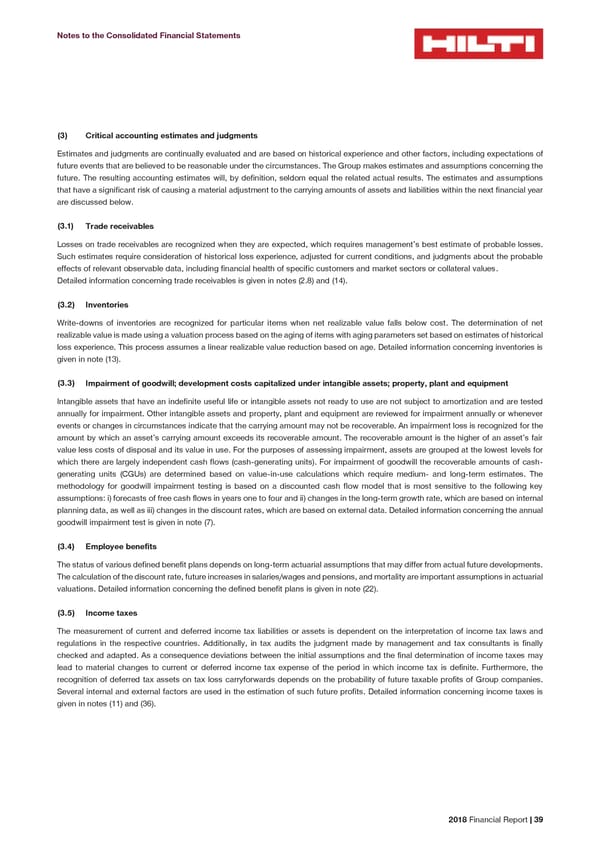Notes to the Consolidated Financial Statements Critical accounting estimates and judgments (3) Estimates and judgments are continually evaluated and are based on historical experience and other factors, including expectations of future events that are believed to be reasonable under the circumstances. The Group makes estimates and assumptions concerning the future. The resulting accounting estimates will, by definition, seldom equal the related actual results. The estimates and assumptions that have a significant risk of causing a material adjustment to the carrying amounts of assets and liabilities within the next financial year are discussed below. (3.1) Trade receivables Losses on trade receivables are recognized when they are expected, which requires management’s best estimate of probable losses. Such estimates require consideration of historical loss experience, adjusted for current conditions, and judgments about the probable effects of relevant observable data, including financial health of specific customers and market sectors or collateral values. Detailed information concerning trade receivables is given in notes (2.8) and (14). (3.2) Inventories Write-downs of inventories are recognized for particular items when net realizable value falls below cost. The determination of net realizable value is made using a valuation process based on the aging of items with aging parameters set based on estimates of historical loss experience. This process assumes a linear realizable value reduction based on age. Detailed information concerning inventories is given in note (13). (3.3) Impairment of goodwill; development costs capitalized under intangible assets; property, plant and equipment Intangible assets that have an indefinite useful life or intangible assets not ready to use are not subject to amortization and are tested annually for impairment. Other intangible assets and property, plant and equipment are reviewed for impairment annually or whenever events or changes in circumstances indicate that the carrying amount may not be recoverable. An impairment loss is recognized for the amount by which an asset’s carrying amount exceeds its recoverable amount. The recoverable amount is the higher of an asset’s fair value less costs of disposal and its value in use. For the purposes of assessing impairment, assets are grouped at the lowest levels for which there are largely independent cash flows (cash-generating units). For impairment of goodwill the recoverable amounts of cash- generating units (CGUs) are determined based on value-in-use calculations which require medium- and long-term estimates. The methodology for goodwill impairment testing is based on a discounted cash flow model that is most sensitive to the following key assumptions: i) forecasts of free cash flows in years one to four and ii) changes in the long-term growth rate, which are based on internal planning data, as well as iii) changes in the discount rates, which are based on external data. Detailed information concerning the annual goodwill impairment test is given in note (7). (3.4) Employee benefits The status of various defined benefit plans depends on long-term actuarial assumptions that may differ from actual future developments. The calculation of the discount rate, future increases in salaries/wages and pensions, and mortality are important assumptions in actuarial valuations. Detailed information concerning the defined benefit plans is given in note (22). Income taxes (3.5) The measurement of current and deferred income tax liabilities or assets is dependent on the interpretation of income tax laws and regulations in the respective countries. Additionally, in tax audits the judgment made by management and tax consultants is finally checked and adapted. As a consequence deviations between the initial assumptions and the final determination of income taxes may lead to material changes to current or deferred income tax expense of the period in which income tax is definite. Furthermore, the recognition of deferred tax assets on tax loss carryforwards depends on the probability of future taxable profits of Group companies. Several internal and external factors are used in the estimation of such future profits. Detailed information concerning income taxes is given in notes (11) and (36). 2018 Financial Report | 39
 2018 Financial Report Page 40 Page 42
2018 Financial Report Page 40 Page 42